Franco-American Love Story
By Philippe Defechereux © 2008
To read Part I, click here.
To read Part II, click here.
Our tale of the extraordinary love affair between a small French car maker, Deutsch-Bonnet, and an American father-son pair, tied to the birth and future success of the Sebring Twelve-Hours, concludes in this issue.
Here we recount how the Deutsch-Bonnet HBR5 Cotard Coupe, which originally raced at Sebring in 1959, was literally resurrected in 1999-2000 by the son of Hobart Cook, the key protagonist who brought Deutsch-Bonnet to Sebring in 1952. After the car was impeccably restored, Arthur “Skip†Cook took it to and raced it in the first Le Mans Twenty-Four Hour Classic in 2002. Exactly fifty years had passed since the birth of the Sebring Twelve Hours. Thus was this extraordinary saga memorably concluded.
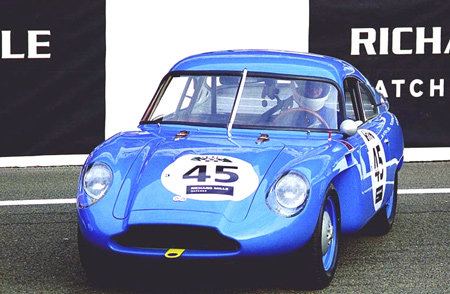
Deutsch-Bonnet HBR5, chassis #1057 at the Le Mans Vintage 24 Hours event in 2002. Powerplant is race-tuned Panhard flat twin 850cc engine. Skip Cook at the wheel. Photo © Derek Fritz.
Coming Full Circle: Sebring 1952 – Le Mans 2002
Harry A. Newton was an imposing Renaissance man who acquired a taste for European cars as salesman for Morlee Motors of Greenwich, CT in the late 1950’s. He rose to prominence after signing up as sales manager for S. J. Inskip in New York in 1964, then the world’s largest Rolls Royce distributor. After delivering record results for Inskip, he achieved similar feats with several importers of European cars, including Hoffman Motors. Later he became a renowned automotive journalist and historian with a vast network of friends and contacts on both coasts. Hobart “Bill†Cook had been one of these and Harry Newton, who by then had moved to Marina del Rey, was now a friend of his son, Arthur B. Cook, known as “Skip,†of Pacific Palisades, CA.
After another friend, Raymond Milo, owned the remains of a rare Cotard-bodied D.B., Harry Newton thought Skip Cook just might be the right customer for the mummified D.B. He knew that Hobart Cook’s son, who had made his a career as a lawyer, was beginning to consider vintage racing as a hobby, though at the time Skip Cook had no performance driving experience at all. A light coupe with a small-bore engine and solid road-holding credentials might just be the right way to start the new adventure.
Skip Cook had the documentation concerning the car mailed to him, including a few pictures of the scattered parts, big and small. After reviewing the dossier, Skip Cook decided to buy the car, sight unseen, then had the crates and moving cartons shipped to the garage of Garry Wales in Woodland Hills, CA.
After the container from New Jersey arrived in Woodland Hills in early 1999 and was unloaded, the new owner and Garry Wales discovered the bodywork not only in primer, but with its interior jam-packed with two engines and dozens of boxes filled with loose parts. The good news was that nothing important seemed to be missing.
Master restorer Tony Nicosia of Costa Mesa, CA, was entrusted with the task of coming up with a full inventory of what had been shipped, then a rough estimate for a restoration schedule.
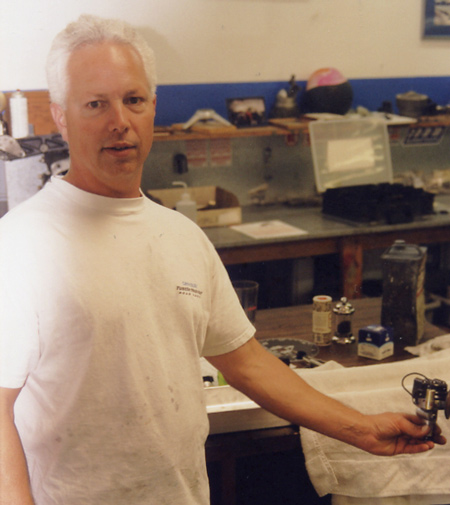
Tony Nicosia holding about the only thing that was missing from the parts that came with the car. A French-made distributor… but not just any distributor… but one with a “flat cap” model, similar to the Fiat 600’s, whose leads exit horizontally from the cap. The standard distributor has leads exiting vertically from the top of the cap and won’t fit under the low hood. Courtesy Harry A. Newton.
His first guess for the latter was six months; it would turn out to be triple that. Meanwhile, Skip Cook was undergoing a transformation of sort about his new field of interest. As he developed a network of collectors, aficionados and vintage car experts to help him in his D.B. project, he became much more committed to becoming a serious vintage car racer and Concours d’Elegance participant. As a result, his quality criteria for the restoration job went up, which accounted for some of the extra time needed to fully resurrect chassis #1057 to its full glory.
During the time the restoration slowly but surely progressed, Skip Cook’s fervor for vintage racing continued to grow. Not only did he expand his network of contacts across the Atlantic to European Deutsch-Bonnet and Panhard experts and enthusiasts, but he also attended the Bob Bondurant and Skip Barber schools for racing drivers. Month by month, his knowledge and expertise about his specific car and its original makers grew, and this was passed on to Tony Nicosia, so the end result would prove simply splendid. There was a dedicated effort to have every piece of D.B. chassis #1057 be part of the resurrected car, with two exceptions: a new Panhard engine from the right vintage needed to be found and modern racing safety equipment needed to be fitted.
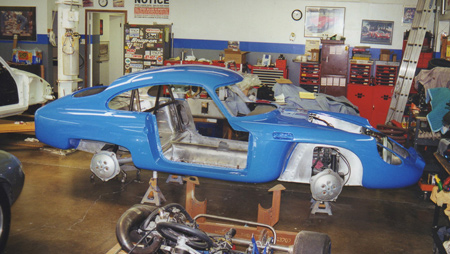
The D.B. chassis #1057 being fitted at Ryan Racing Restorations with safety equipment. The formula for the French racing blue color was carefully reseached by Skip Cook. Courtesty of Arthur B. Cook.
The engine challenge would later be solved when Skip Cook, through his new network of Deutsch-Bonnet friends, located a “period-correct†850cc Panhard dual ignition, racing flat-twin. Fitting the safety equipment, final assembly, painting, upholstery installation, mechanical tuning and testing were entrusted to Paul Schaller and Kevin Ryan of Ryan Racing Restorations, then also located in Costa Mesa.
Kevin Ryan ran the shop, but his partner Paul Schaller was primarily responsible for the D.B. project. Schaller took extreme care for every detail, including fitting the required safety items, such as a roll bar, a fuel cell, fire suppression system and five-point seatbelt, as unobtrusively as possible. The top of the roll bar, for instance, evenly matches the inner curve of the roof. Schaller also rebuilt the engine with high compression ratio and twin carburetors; it would prove able to deliver over 85 hp at a maximum of 7500 rpm.
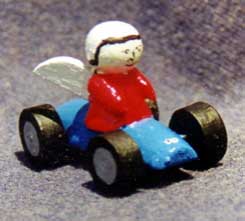
Italians have been known to leave wine
bottles in the bodywork: the French
prefer to keep their wine bottles and
leave mascots! It can be seen in the
glove box. Courtesty of Arthur B. Cook.
In its final races before being boxed, the Cotard bodywork had suffered a number of bruises that, once in the hands of Tony Nicosia, required some serious efforts to redress. At one point, it was decided the left rocker panel had to be opened.
When it was, a little racing angel appeared! Clearly placed there by a facetious French worker who never dreamed it would ever be found, it was a small mascot made out of sculpted wood and representing a winged angel driving a Formula 1 racer. Skip Cook personally restored and painted it, then, protected by a Lucite box, glued it in the middle of the doorless glove box.
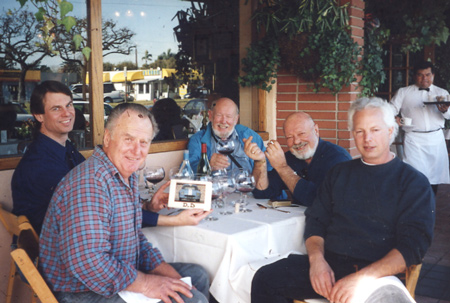
Celebratory group lunch; early 2000. Left to right, Skip Cook, Willy Mueller (French car enthusiast), Harry Newton, Raymond Milo and Tony Nicosia. The Golden Truffle is a hang out for gearheads. The owner/chef is a motorsports fan whose catering service has been employed by F1 teams.
Courtesy Arthur B. Cook.
Skip Cook took his first baby steps in vintage car racing by testing the car at Willow Springs on April 1, 2000. Since the newly bought racing engine would not be properly refurbished until year end, he had Ryan fit a stock Panhard equivalent featuring a single carburetor, and producing 65hp at 6000rpm for his first season. Everything went well, including the fact the tall driver (6’4â€) fit quite comfortably in the cockpit. That was another Deutsch-Bonnet characteristic that American drivers much appreciated from the early days onward.
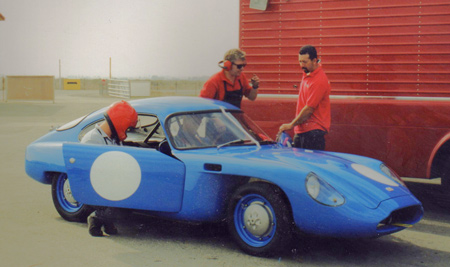
April 21, 2000 at Willow Springs: the D.B. has just been unloaded and
is being readied for its very first run. Kevin Ryan wears ear-protection
gear and Paul Schaller a helmet as the the car’s muffler had not been
fitted yet. The decibels were very high.
By the time his second season of racing came to an end, Skip Cook had not only become enthusiastic about vintage car racing, but also reconnected with the history of his father’s momentous involvement with Alec Ulmann, Sebring and Deutsch-Bonnet. There was now a clear father-and-son component to the emotional mix that tied him to his French racer and his new passion. Skip soon attended and graduated from several racing schools, including Danny McKeever’s Fast Lane Driving School at Willow Springs, Jim Russell at Sears Point, Bob Bondurant in Phoenix and Skip Barber at Laguna Seca. Eventually, he cut his teeth in actual races at Elkhart Lake, Watkins Glen, Laguna Seca and Las Vegas, among others. Skip reconnected with his father’s longtime friend Wade Morehouse, co-driver of the Index winning D-B in both the ’52 and ’53 12 Hours of Sebring. Morehouse, now a resident of Oakland, California joined Skip at Sears Point and rode in #1057 as Skip’s passenger for a few hot laps of the track.
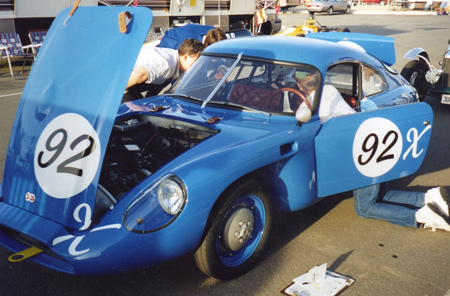
Technical inspection for the May VARA race. Racing number 92 has a
secret meaning kept between father Hobart and son Arthur. The “Xâ€
next to it indicates “rookie driver.†Courtesty of Arthur B. Cook..
Towards the end of 2001, Skip learned that the Automobile Club de l’Ouest (ACO) planned to stage the first-ever vintage edition of the Le Mans 24-Hours, scheduled for September 21 and 22, 2002. Only authentic cars having raced at Le Mans, or of the same series as those who raced at Le Mans, would be allowed to participate. The event would be staged on the full 8.5 miles circuit.
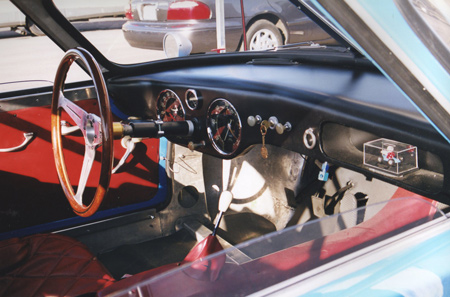
The D.B. cockpit with all safety gear. The racing mascot can be seen
in the glove box. Courtesty of Arthur B. Cook.
Skip Cook quickly noticed that 2002 would be exactly fifty years since the first Deutsch-Bonnet team, financed by his father, had raced at Sebring and caused a sensation. His mind was soon made up; he would ship his little French racer to France and participate in that event. After racing it at Las Vegas in March, 2002, then at Sears Point in May, he began to make preparations to have it shipped to the Sarthe circuit in time for the Vintage 24-Hours. As e-mails and faxes streamed from the ACO, he learned that the number of entrants was both large, of superb quality and spanning the years 1923 to 1975. Jaguars, Aston Martins, ACs, Ferraris, Maseratis, Alfa-Romeos, Porsches, Delayayes, Talbots, Gordinis and, of course, Deutsch-Bonnets, would all be there.
At final count, there were exactly 300 entrants, divided into five groups according to year of manufacture: 1923-39; 1945-56; 1957-61; 1962-65 and 1966-75. Each group would have four races lasting about half-an-hour. After Group One finished its first race (to start at 4pm like the real race), Group Two have its own, then Group Three, and so on; until it was Group One’s turn again, but with about three hours having passed and the sun lower on the horizon. This clever planning meant that all participants would end up having a 24-hour racing experience on the hallowed circuit, including night racing, but without the stress, expense and logistical needs to compete for a full 24-hours.
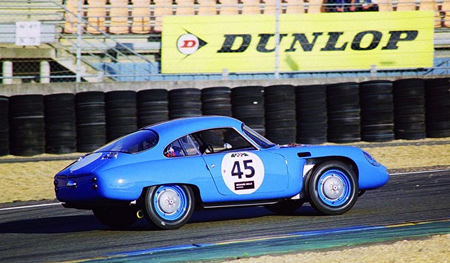
The “American D.B.†tackles the uphill at Le Mans, 2002.
© Derek Fritz
Since D.B. chassis #1057 had been shipped directly from the factory to America back in 1959 (even its instrument panel is in American measurements), and had never left America until Skip Cook shipped it to France, this race would be the first time this French car would “turn its wheels in anger†on its native French soil. Slotted in Group Three next to powerful Jaguars and Ferraris, the tall American (“grand gaillard†as the French called him) handled his D.B. well and, even more important, enjoyed himself tremendously, with a sense of awe. He confided that “Driving down the Mulsanne Straight, or turning into Arnage, thinking of how many great drivers managed these challenges at maximum possible speed made me feel very lucky I was, in my own modest way, reliving their past exploits.â€
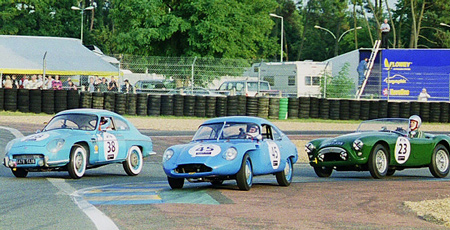
Skip Cook leading another D.B. Coupe and an AC out of a turn at the
first Le Mans Classic 24 Hour race, September 2002. © Derek Fritz
There were three Deutsch-Bonnets participating in the event. The eldest was a pre-war Citroën-powered car, one of the first built by Deutsch-Bonnet. The second one was a standard HBR5 owned by Frenchman Gérard Aupetit. The third was chassis #1057. Several of the European publications reporting on the event later in 2002 featured a color photo of Skip Cook’s car (even British magazine “The Automobileâ€) praising its pedigree and perfect state of restoration. By the time both car and owner had returned to California, Skip Cook felt he had “closed a fifty-year circle†his father had started in 1952. This was a truly Franco-American “Happy Ending.â€
Skip Cook continues to race his Deutsch-Bonnet on a regular basis on tracks as distant as Laguna Seca and Watkins Glen. The car was also exhibited at Pebble Beach (Quail Lodge) in 2007 – see photo in Part I. This writer had the privilege of riding in the car along the Pacific Coast, with Skip at the wheel, last November. The experience was so thrilling, it became the inspiration for this three-part article.